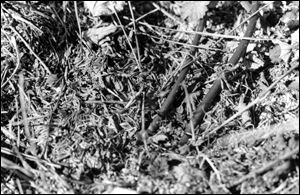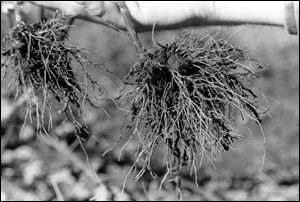Layering Layering is a method of making a stem cutting while the cutting is still attached to the parent plant. In layering, a portion of the stem is buried in the soil. Roots then form on the stem, and a complete plant - both stem and roots - can be cut from the parent plant. The layering technique is often successful because the “new” plant continues to receive water and nutrients from the parent plant until it is cut off. The trailing brambles (blackberry and raspberry) and muscadine grapes are the fruit plants most commonly propagated by layering. Simple Layering Simple layering can be accomplished by bending a low growing, flexible stem to the ground. Cover part of it with soil, leaving the remaining 6 to 12 inches above the soil. Bend the tip into a vertical position and stake in place (Fig. 1). The sharp bend will often induce rooting, but wounding the lower side of the bent branch may help also. Simple layering can be done on most plants with low-growing branches. Examples of plants propagated by simple layering include climbing roses, forsythia, rhododendron, honeysuckle, boxwood, azalea, and wax myrtle. 1 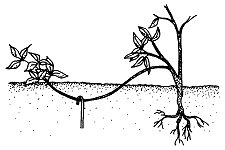 Fig. 1 Simple layering can be done in early spring using a dormant branch, or in late summer using a mature branch. Periodically check for adequate moisture and for the formation of roots. It may take one or more seasons before the layer is ready to be removed for transplanting. 1 Muscadine grapes are often propagated by simple layering—placing soil over the mid-portion of new shoots in late June or early July, leaving the shoot terminal exposed. Roots will form where the vine is covered with soil. These rooted layers can be removed from the mother plant during the dormant season and transplanted. If a number of plants are desired, take an entire fruiting arm of the muscadine vine and lay it in a shallow trench in late June or July. Cover it with 4 to 5 inches of soil and leave the tips of all the growing shoots uncovered. Most of these shoots will root and form new plants. In the winter, remove the soil and cut the rooted shoots from the mother plant. 3 Tip Layering Tip layering is similar to simple layering and happens naturally with plants such as black raspberry and trailing blackberries. The tip of a branch touches the ground and roots form. Tip layering simply mimics this natural process. 2 Trailing bramble plants often tip layer naturally late in the season. The terminal of the vigorously growing bramble canes will grow into the soil (Fig. 3) and form a mass of roots. These rooted tip layers can be dug in the winter (Fig. 4) and planted in the desired location. 3 To tip layer, dig a small hole several inches deep, insert the tip of a current season's shoot or cane, and fill around it with soil. The tip will turn and grow upward, while the bend of the stem that stays in the soil will grow roots. Care for the layered plant is the same as that used for simple layering. 2 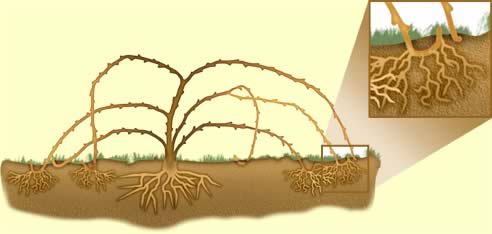 Fig. 2 Diagram of tip layering
To ensure tip layering, nurserymen often place a half shovel of soil over the terminals of the canes in late August. By placing the soil over the tip, the resulting layers generally develop a larger root system. 3 Compound (serpentine) Layering 1 Compound (serpentine) layering is similar to simple layering, but several layers can result from a single stem. Bend the stem to the rooting medium as for simple layering, but alternately cover and expose sections of the stem. Each section should have at least one bud exposed and one bud covered with soil. Wound the lower side of each stem section to be covered (Fig. 5). This method works well for plants producing vine-like growth such as heart-leaf philodendron, pothos, wisteria, clematis, and grapes. 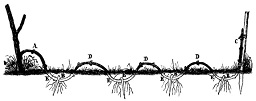 Fig. 5  Mound (stool) Layering 1 Mound (stool) layering is useful with heavy-stemmed, closely branched shrubs and rootstocks of tree fruits. Cut the plant back to 1 inch above the soil surface in the dormant season. Dormant buds will produce new shoots in the spring. Mound soil over the new shoots as they grow (Fig. 6). Roots will develop at the bases of the young shoots. Remove the layers in the dormant season. Mound layering works well on apple rootstocks, spirea, quince, daphne, magnolia, and cotoneaster. 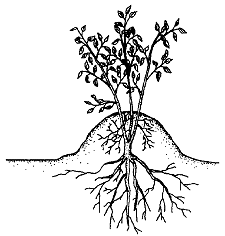 Fig. 6 Care of Layered Plants 2 It is easy to care for houseplants that have been layered. Cut the rooted plant off the parent plant and pot it up. If the root system is small, it may not be able to take up enough water to support a large number of leaves. Trim the top of the plant to a size that is proportional to the size of the rootball. Place a plastic bag over the newly potted plant for a few days to reduce water loss as the roots become established It is also easy to care for woody plants that have been layered. Plants layered in spring will usually have roots by the end of summer. That fall or the next spring before growth starts, cut them from the parent plants and transplant. You might want to consider planting them initially in a pot that can be protected from severe weather until the roots become established. Plants layered mid-summer should be left through the winter, then cut off and transplanted the next spring before new growth begins. Protect them from severe weather for the first few weeks after replanting. Natural Forms of Layering 1 Sometimes layering occurs naturally, without the assistance of a propagator. Runners and offsets are specialized plant structures that facilitate propagation by layering. A runner produces new shoots where it touches the growing medium (Figure 5). Plants that produce stolons or runners are propagated by severing the new plants from their parent stems. Plantlets at the tips of runners may be rooted while still attached to the parent or detached and placed in a rooting medium. Examples include strawberry and spider plant.  Fig. 7 Plants with rosetted stems often reproduce by forming new shoots, called offshoots, at their base or in the leaf axles. Sever the new shoots from the parent plant after they have developed their own root systems. Unrooted offsets of some species may be removed and placed in a rooting medium. Some of these must be cut off, whereas others may simply be lifted from the parent stem. Examples include date palm, bromeliads, and many cacti. 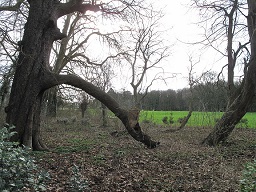 Fig. 8  Horse chesnut layering in the park of Noisiel (Seine-et-Marne, France) 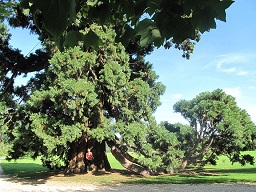 Fig. 9  Sequoiadendron giganteum layering in the park of the castle of Rentilly (Seine-et-Marne) Further Reading Layering Propagation for the Home Gardener, Oklahoma State University, Cooperative Extension pdf Back to Propagation Page |
||||
| Bibliography 1 Evans, Erv, et al. "Plant Propagation by Layering: Instructions for the Home Gardener." Dept. of Horticultural Science, North Carolina State University, Jan. 1999, NCSU, ces.ncsu.edu. Accessed 26 May 2014. 2 "Plant Propagation: Layering." Purdue University Extension, extension.purdue.edu. Accessed 26 May 2014. 3 Ferree, M. E., and Gerard Krewer. "Propagating Deciduous Fruit Plants Common to Georgia." University of Georgia Cooperative Extension, Reviewed Feb. 2012, Full Review Feb. 2015, UGA, caes.uga.edu/extension.uga.edu/publications/detail.html?number=B818&title=Propagating%20Deciduous%20Fruit%20Plants%20Common %20to%20Georgia. Accessed 17 Aug. 2018. Photographs Fig. 1,6,7 "Plant Propagation By Layering: Instructions for the Home Gardener." Dept. of Horticultural Science, North Carolina State University, Jan. 1999, NCSU, ces.ncsu.edu. Accessed 26 May 2014. Fig. 2 "Plant Propagation: Layering." Purdue University Extension, extension.purdue.edu. Accessed 26 May 2014. Fig. 3,4 "Propagating Deciduous Fruit Plants Common to Georgia." University of Georgia Cooperative Extension, Reviewed Feb. 2012, UGA, caes.uga.edu/ Accessed 26 May 2014. Fig. 5 Du Breuil, Alphonse. "Marcottage en serpenteaux." Wikimedia Commons, 31 Dec. 1845, Public Domain, commons.wikimedia.org/wiki/Category:Layering#/media/File:Marcottage_en_serpenteaux.png. Accessed 22 Aug. 2018. Fig. 8 Tangopaso. "Horse chesnut layering in the park of Noisiel (Seine-et-Marne, France)." Wikimedia Commons, 16 Feb. 2014, Public Domain, commons.wikimedia.org/wiki/Category:Layering#/media/File:Marronnier_en_marcotte.jpg. Accessed 22 Aug. 2018. Fig. 9 Tangopaso. "Sequoiadendron giganteum layering in the park of the castle of Rentilly (Seine-et-Marne), France." Wikimedia Commons, 11 Sept. 2010, Public Domain, commons.wikimedia.org/wiki/File:Sequoiadendron_layering.jpg. Accessed 22 Aug. 2018. Published 26 May 2014 LR. Last update 22 Aug. 2018 LR |
||||
